An estimated 17% of kids will sleepwalk at some point, typically starting between ages 6-12 before resolving in adolescence. Though unnerving when it happens, sleepwalking is generally harmless. Understanding the various sleepwalking symptoms, what causes sleepwalking, how to handle episodes safely, and when to be concerned can help parents manage this disruptive nighttime behaviour.
What Does Sleepwalking Look Like?
You know how kids are totally out cold in that deep, dead-to-the-world sleep early in the night? Sleepwalking typically occurs in such moments. Sleepwalking is also known as somnambulism. Your child may awaken from a deep slumber and sit upright in bed, eyes wide open. They may look to be awake, yet they are still asleep; despite having their eyes open, they have a lifeless, zombie-like expression.
Before you can snap them out of it, your kid may climb right out of bed and start slowly wandering around the room. Arms stretched out in front of them like Frankenstein, bumping into things but not waking up. You call their name over and over, but no response. They just keep lurking around with that empty look on their face, totally oblivious to you and the world around them. Then after a few minutes, they crawl back into bed dead asleep, and wake up with zero memory of acting out their dreams! Spooky for parents to see, but perfectly normal sleepwalking behaviour.
Common sleepwalking behaviours or sleepwalking symptoms can include:
Getting out of bed and wandering about your bedroom or place
Opening drawers, closets, refrigerators, cabinets, and doors
A blank stare with their eyes open but a glazed over expression
No response or nonsensical, confused responses when others attempt to interact
Difficulty awakening or communicating during the episode
Later having no memory of the sleepwalking event
Sleepwalking episodes typically last between 1 to 15 minutes, though they can occasionally be longer. Your child may eventually get back into bed and fall back asleep on their own. If that is not the case, you, yes you, can guide your little one:)
What Causes Sleepwalking in Children?
While genetics and a family history of sleepwalking are risk factors, experts believe there are various triggers that can cause sleepwalking episodes in vulnerable children:
- Sleep Deprivation
- Inconsistent Sleep Schedules
- Sleep Disorders
- Stress, Anxiety, Trauma
- Travel and Unfamiliar Environments
Not getting adequate deep restorative sleep is believed to be a major contributor to sleepwalking. Sleep deprivation leads to instability in the brain cycling between sleep stages, which can trigger partial awakenings and confused sleep-wake states like sleepwalking.
As difficult as it may be, try to keep your child’s routine consistent each night. Even on Saturdays and Sundays, the bedtime and wake-up times remain the same! Setting an internal alarm clock for the same time every day can assist reduce their brain’s cycling in and out of deep sleep. Then hopefully you’ll deal with less sleepwalking and more peaceful nights!
Various sleep disorders may increase the likelihood of sleepwalking. Conditions like sleep apnea that fragment sleep architecture and disrupt deep REM sleep are associated with a higher incidence of sleepwalking events.
Stress hormones and neural excitation can lead to instabilities between sleep and wake states. Relaxation therapies may help reduce sleepwalking associated with stress.
Sleepwalking episodes often occur when children sleep in unfamiliar environments. Things like travelling, sleeping over with friends, or other disruptions in routine can trigger episodes in susceptible kids. Bringing comforting objects from home may help with sleepwalking when away.
Safety Tips for Parents of Sleepwalking Children
Seeing your child up and about with an altered consciousness can be troubling. While occasional sleepwalking is usually harmless, parents should take some safety precautions and handle episodes gently. Here are some tips for managing sleepwalking:
Childproof the house and bedroom by removing tripping dangers and installing safety gates on stairways. This prevents injury if they walk around.
Gently guide the child back to bed when sleepwalking without fully waking them. Don’t restrain or grab them aggressively as this may prompt confusion or anxiety.
Speak softly and calmly if needing to intervene during an episode. Do not shake or shout at the child.
Keep doors secured with alarms in case they try to go outside which could be dangerous.
Use secure screens on windows that cannot be opened fully to prevent potential falls.
Note any patterns surrounding sleepwalking occurrences and discuss with your doctor.
Overall, remaining calm, gently reassuring, and creating a safe environment are the best ways parents can deal with sleepwalking when it occurs.
When Should I Call the Doctor About Sleepwalking?
Sleepwalking treatment becomes necessary in certain cases. Occasional, benign sleepwalking is common in childhood and unlikely to signify any serious problem on its own. However, parents should contact the child’s physician if:
Sleepwalking becomes frequent and disruptive, happening many times a week.
Episodes involve violent, injurious, or dangerous behaviour.
The child is impossible to awaken or console when sleepwalking.
Sleepwalking persists over the age of 12 years old.
Significant daytime sleepiness, fatigue or other cognitive issues occur due to disrupted sleep.
The child experiences other parasomnias like sleep terrors alongside sleepwalking.
There are signs of an underlying sleep disorder like snoring, breathing cessations, or excessive night awakenings.
The doctor can evaluate for other sleep disorders, review medications, and consider referral to a paediatric sleep specialist or sleep lab for polysomnography testing if underlying issues are suspected.
Home Remedies and Lifestyle Tips for Sleepwalking
While medical therapy is rarely needed, parents can utilise some helpful home strategies to better cope with occasional sleepwalking episodes when they occur:
Maintain a soothing, relaxing bedtime routine including a warm bath and light reading.
Avoid scary stories, movies, video games or excitants like caffeine before bed.
Use a white noise machine or humidifier to promote restful sleep.
Have your child keep a regular daily exercise routine, but not immediately before bed.
Sleepwalking treatments at home is all about making these observations and adjustments. Making positive sleep environment adjustments, promoting sleep health, and maintaining stable routines can help minimise sleep disruptions and reduce sleepwalking over the long-term.
In summary, sleepwalking can be an unnerving phenomenon but is typically a transient aspect of paediatric sleep development. While startling, sleepwalking itself is not dangerous for most children. Being aware of the signs, triggers and best practices for handling episodes can help parents keep their sleepwalking child stay safe with minimal disruption. In most cases, providing proper sleep hygiene, following paediatrician guidance and taking simple precautions is all that is required until a child eventually outgrows this temporary nighttime conduct.
For more interesting blogs like these, head over to our blog section!














